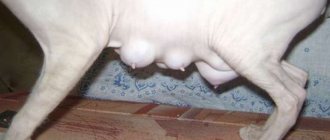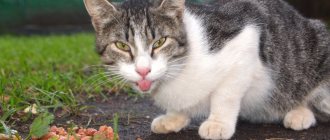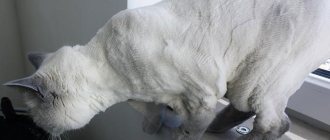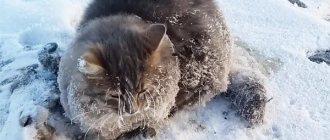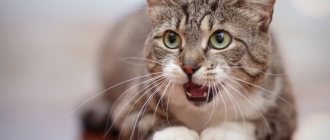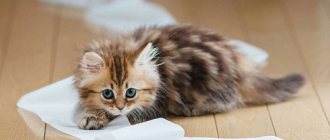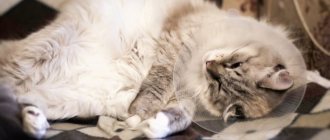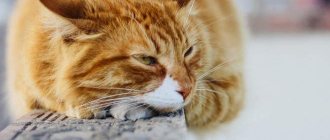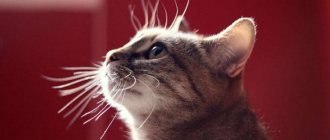A condition such as shortness of breath in a cat can be physiological and pathological. In addition to breathing problems, the owner should pay attention to symptoms such as bluish mucous membranes, wheezing, and increased temperature. At the first signs, the owner should take the pet to a veterinarian, who will diagnose and prescribe appropriate therapy.
According to the observation of veterinarians, shortness of breath in a cat is often provoked by heartworms, which are localized in the heart and have symptoms similar to asthma.
Causes of shortness of breath
Normally, the frequency of inhalation/exhalation in a cat is from 12 to 30 movements per minute. Deviation from the indicators indicates the development of the disease. The most common causes of shortness of breath are the following factors:
- nasal polyps and tumors;
- foreign objects accidentally falling into the nasal opening;
- bronchitis or pneumonia;
- pulmonary edema;
- cardiovascular diseases;
- neoplasms in any respiratory organ or chest;
- helminthic infestation;
- asthma;
- fall from height and injury to the chest, head or internal organs;
- traumatic brain injury or cancer in the brain that causes breathing problems;
- accumulation of fluid, blood or pus in the pleural cavity;
- infection by pathogenic fungi of the respiratory system;
- anemia;
- drug overdose or poisoning;
- thromboembolism;
- intoxication of the body due to kidney diseases;
- ascites;
- diseases of the thyroid gland, in which the organ enlarges;
- obesity;
- sun or heatstroke;
- long-term physical activity.
What are the different types of the condition?
Natural shortness of breath
The owner need not worry if this condition occurs in the pet after he has been actively playing.
Breathing disorders occur due to overheating, active games, and stressful situations. Such shortness of breath goes away if the animal is calmed and placed in a cool place. During increased activity, the cat accelerates all vital processes, in particular, pulmonary gas exchange. To replenish the loss of oxygen, the cat breathes frequently. When a pet is frightened, adrenaline is released into the blood, which stimulates cardiac activity.
If your cat is breathing rapidly and has an open mouth, like a dog, this is a sign of overheating. Especially often, temporary breathing problems can be observed in the hot season after active games. It differs from pathological in the absence of health disorders and passes quickly. Also, rapid breathing may be a feature of the breed: Siamese and Oriental cats take more breaths than European representatives.
Dangerous shortness of breath
Respiratory movements are combined with the depressed state of the cat and occur against the background of serious illness or injury. Veterinarians divide pathological respiratory failure into the types shown in the table:
| Variety | Characteristic |
| Tachypnea | Inhalations/exhalations are frequent and shallow |
| Bradypnea | Respiratory rate is reduced |
| Expiratory breathing | The cat has a hard time breathing out |
| Inspiratory dyspnea | It's hard for your pet to breathe |
| Expiratory-inspiratory dyspnea | The cat has difficulty breathing while inhaling and exhaling |
Signs of pathology
Frequency is the total number of breaths taken in 1 minute.
The normal breathing rate for a cat is 20-30 breaths per minute. In this case, slight deviations in both directions are possible. For example, a cat that inhales up to 35 times per minute, in the absence of other symptoms indicating illness, is completely healthy.
It is normal to inhale more frequently after physical activity and during hot weather. This is how the body tries to cool down.
During times of fear or stress, a cat's breathing may also become faster.
We suggest you read: Deworming tablets for cats: instructions for use
If breathing problems are not associated with these reasons and have the symptoms described above, you cannot postpone a visit to the veterinarian.
In the article I talked about respiratory dysfunction in cats. She listed its signs and possible causes. Describes cases in which changes in inhalation are normal and those in which urgent veterinary attention is needed, including signs that are similar in young kittens.
The normal breathing rate for a cat is considered to be from twenty to forty exhalations per minute. However, there are situations when a pet’s breathing is impaired. When a cat breathes with its stomach, the lungs and chest cannot cope with their functions, since in a normal case a vacuum forms around the lungs in the chest cavity and allows the organs to have space.
Due to certain problems with the body, both air and blood along with harmful substances can enter the cavity. This may also be due to increased physical activity, various pathologies and severe climatic conditions. This can also be caused by the onset of labor in a cat and stressful situations. Any of these options will be a reason to visit a doctor.
Everyone is familiar with the situation when a cat sticks out its tongue to wash itself or lap up milk. However, there are situations when you should worry about the condition of the animal.
And it is also important to note that the cause of this phenomenon is cardiovascular failure, poisoning and disorders in the brain. When poisoning occurs, vomiting occurs, the animal begins to cough, and as a result, all harmful substances leave the body. When disturbances occur in the brain, the cat is unable to control the movements of its body, including its tongue. Additionally, the cat may be accompanied by strabismus and other diseases.
3. Food absorption.
4. Overheating.
6. Dehydration.
7. Poisoning.
11. Anemia.
12. Fever.
It is necessary to ensure that the animal does not overheat in the summer, do not overload it beyond measure, and do not overfeed it. It is very good if, from childhood, the kitten is surrounded by a calm, friendly environment.
When I first saw my cat Basya, running after a toy, sitting with her paws wide apart and breathing “like a dog” with her mouth open, I was seriously alarmed. Of course, an eight-month-old clinically healthy cat suddenly demonstrates such obvious respiratory failure!
But I didn’t worry for long. Because I remembered that I am a doctor after all. I looked at the color of the mucous membranes, saw that every minute the cat’s breathing was becoming calmer and less deep, and realized that this shortness of breath was only physiological, i.e. naturally determined, adaptive.
Now, when my two Bengal beauties are jumping along the walls of the apartment at crazy speed, I am already quite calmly watching as one of the cats, then the other, briefly “leaves the game” to catch their breath. However, I can imagine the feelings of an attentive owner who suddenly notices that his pet or pet is experiencing a clear lack of air.
I think it’s time to figure out what shortness of breath is, and in what cases it is a sign of terrible danger for your pet.
Shortness of breath (dyspnea) is a violation of the frequency and depth of breathing, accompanied by a feeling of lack of air. This is one of the most common types of breathing problems. When shortness of breath, the animal tries to reduce its activity.
When cats are short of breath, they first breathe heavily, flaring the wings of their nose, and then begin to breathe like a dog, with their mouth open. As shortness of breath intensifies, deep movements of the ribs begin, and in the most severe cases, the abdominal muscles also become involved, driving air through the lungs.
A cat breathing “like a dog” is a sign of shortness of breath
Dogs can breathe frequently with their mouths open without developing shortness of breath. This happens because the dog’s body cools through the tongue, or more precisely as a result of the evaporation of saliva from the tongue. This mechanism does not work in cats, so any breathing with an open mouth in a cat is already a sign of shortness of breath.
To tell if your dog is developing shortness of breath, pay attention to the movement of his chest. In the “cooling mode,” the dog’s breathing is rather shallow, and chest movements are unnoticeable. In the case of shortness of breath, the dog breathes deeply and frequently, the movements of the chest are strongly expressed, and, in addition, “abdominal” breathing is observed with contractions of the abdominal muscles.
Shortness of breath can be physiological and pathological.
Physiological shortness of breath is breathing designed to restore oxygen levels during high physical exertion or during stress, when an increase in the level of metabolic processes requires an increased level of oxygen supply.
Physiological shortness of breath helps to quickly restore the required level of oxygen in the blood.
Physiological dyspnea is often observed in brachycephalic dogs and cats and in very active animals in hot weather. If the animal’s activity remains at the usual level, and shortness of breath stops quickly, then there is no cause for concern.
Pathological shortness of breath is a condition when the animal does not have enough oxygen at rest or during minor physical exertion. At this moment, at a reflex level, the dog or cat feels a “lack of air” and tries to breathe more and more actively. This occurs due to the fact that some parts of the respiratory system are not working to their full potential (respiratory shortness of breath).
Heart failure can also cause pathological shortness of breath (cardiac dyspnea). If the heart is not able to “pump” the required amount of blood through the lungs, then the brain senses a lack of oxygen and gives a signal to the respiratory system - “breathe more actively!” But this does not lead to the desired result, the signal to increase breathing comes again, the load on the chest muscles and heart muscle increases, oxygen consumption by the muscles increases, and the pathological circle closes.
Other causes of shortness of breath include anemia, endocrine disorders (obesity, diabetes, thyrotoxicosis), toxic disorders (renal and liver failure) - hematogenous shortness of breath, neoplasms of the brain and spinal cord (central shortness of breath) and a number of other diseases that reduce the level of oxygen in the blood , increasing its consumption or causing pathological signals about a lack of oxygen in the brain. The main thing is that for shortness of breath to develop, the patient must reflexively feel a “lack of air.”
When shortness of breath develops, the patient physically feels a “lack of air.”
You can also distinguish between inspiratory, expiratory and mixed shortness of breath.
Inspiratory dyspnea, or shortness of breath while inhaling, develops when there is a problem in the flow of air into the lungs. Such problems may be narrowness of the nasal canals, spasms of the airways, too long or swollen palate, swelling of the larynx, collapse of the trachea.
Expiratory dyspnea, or shortness of breath when exhaling, is much less common. Its causes may be emphysema, asthmatic conditions, and accumulation of sputum due to bronchitis. In the case of this shortness of breath, there is a problem with removing air from the lungs and replacing it with a new one rich in oxygen.
We suggest you read: Preparing goats for lambing - Goat lambing calendar
Mixed shortness of breath occurs when the patient has difficulty both inhaling and exhaling. This occurs in severe diseases of the lungs, pleura and heart failure.
It is necessary for the doctor to determine the type of shortness of breath in order to most accurately build an algorithm for diagnosing the causes of oxygen deficiency in your pet and its treatment.
You can significantly help the veterinarian if you carefully observe your pet and note in what cases shortness of breath occurs, what causes it, how quickly it goes away and how exactly your pet’s breathing is disrupted.
First of all, by the color of the mucous membranes.
With physiological shortness of breath, the color of the mucous membranes, as a rule, either does not change or becomes more intensely pink and even red. Even if the mucous membranes become bluish for a short time, their color is restored within a few minutes.
With physiological shortness of breath, the pet’s condition is quickly restored in a very short time and does not affect the general background of physical activity.
With pathological shortness of breath, the mucous membranes turn blue in the case of the respiratory nature of the shortness of breath or turn pale in the case of the cardiac or hematogenous nature of this pathological condition. Sometimes the origin of oxygen deficiency in the blood and, accordingly, shortness of breath can be mixed. Then, as oxygen deficiency develops, the mucous membranes become pale bluish or even gray.
If your pet has physiological shortness of breath caused by physical exertion, active play, transportation or a visit to the veterinary clinic, then nothing bad is happening. Just let him catch his breath. Within a few tens of minutes, you will notice how the rhythm and depth of your four-legged breathing is restored.
Signs of danger
The combination of this condition in an animal with an increased need to drink water requires urgent medical intervention.
The following signs indicate an urgent visit to the veterinarian:
- temperature increase;
- body position when the cat lies on its stomach, legs spread out and neck stretched out;
- confusion or loss of consciousness;
- impaired coordination of movements;
- increased thirst;
- lethargy, refusal to play;
- wheezing and whistling during inhalation or exhalation;
- cyanosis or pallor of mucous membranes;
- violation of the frequency of respiratory movements.
Major diseases
All diseases of the digestive tract are divided into infectious (colitis, coronavirus enteritis, gastritis) and non-infectious (constipation, cancer, intestinal obstruction, peptic ulcer, malabsorption syndrome). Let's take a closer look at each disease.
Colitis
Colitis is a disease characterized by inflammation of the large intestine. There are several reasons that lead to the development of the disease:
- Viral or bacterial inflammation.
- Parasitic infestations.
- Damage to the intestinal mucosa by a foreign body.
- Dietary disorder.
Clinically, colitis is manifested by local inflammation in the intestines (secretion of mucus and blood with feces, painful sensations) and intoxication syndrome (lethargy, refusal to eat and play, constant drowsiness).
Constipation
Constipation is a fairly common problem in cats. In this case, the pet rarely defecates; feces remain in the intestinal cavity for a long time and lead to intoxication.
Coronavirus enteritis
Coronavirus enteritis is an inflammation of the small intestine that occurs when exposed to a virus. The disease is infectious in nature and is transmitted by the fecal-oral route. A pet can become infected from sick cats that shed the virus in their feces. Kittens and older pets are more likely to get sick.
Gastritis
Gastritis is a disease characterized by inflammation of the gastric mucosa. The following reasons can lead to the development of gastritis:
- Poisoning (both chemicals and food).
- Dietary disorder (consumption of inappropriate foods).
- Hairball in the stomach.
- Taking certain medications.
- Allergic reaction.
Gastritis can occur in two forms: acute and chronic.
Bowel cancer
Colon cancer is uncommon in cats. It is a malignant tumor that is prone to unlimited growth and metastasis.
It is quite difficult to detect a tumor in the initial stage; most often it is an accidental discovery.
In the later stages, intestinal cancer is manifested by a significant decrease in body weight, lethargy, and apathy. Often, a cat is bothered by constipation and bleeding in the feces.
The prognosis in most cases is unfavorable, but depends on the detected stage and nature of the tumor.
Obstruction
Intestinal obstruction is an acute emergency pathology that, if not intervened in time, leads to death.
Something else interesting: The cat is vomiting white foam
The reasons that lead to the development of obstruction are as follows:
- foreign body;
- intussusception;
- adhesive disease;
- compression by tumor.
The disease can occur in two forms: complete or partial obstruction. Symptoms appear acutely: paroxysmal pain, vomiting, lack of passage of stool and gas.
Peptic ulcer
Peptic ulcer is a pathology of the stomach or duodenum in which ulcers form on the mucous membrane.
There are several reasons why the disease may develop:
- Infectious agents (including helminths).
- Taking certain medications.
- Reduced protective properties of the mucous membrane.
Peptic ulcer disease is a chronic disease, so periods of exacerbation alternate with periods of remission. All symptoms appear in the acute phase: severe pain, signs of gastrointestinal bleeding (vomiting “coffee grounds”, blood in the stool).
Malabsorption
Malabsorption is a condition characterized by impaired absorption of nutrients in the intestine. Malabsorption can occur for several reasons:
- Impaired secretion or function of digestive enzymes (diseases of the pancreas, gall bladder).
- Malabsorption in the small intestine (enteritis).
- Dysbacteriosis.
Clinically, malabsorption is manifested by prolonged diarrhea (sometimes foamy), an increase in the volume of excreted feces, weight loss (due to insufficient intake of nutrients), signs of hypoproteinemia and hypovitaminosis.
Diagnostic measures
To identify the reason why a cat has rapid breathing and heartbeat, the veterinarian asks the owner about possible antecedent factors, conducts a visual examination and prescribes diagnostic methods, such as:
Tonometry can help identify the cause of this symptom in a fluffy.
- X-ray of the sternum;
- electro- or echocardiogram;
- listening to the heart and lungs with a phonendoscope;
- pressure measurement;
- general blood analysis;
- bronchoscopy;
- stool analysis if helminths are suspected;
- puncture of fluid from the pleural area if necessary.
Shortness of breath in a cat. How to help?
We need to help a cat with shortness of breath. Take the sick animal to the veterinary clinic as quickly as possible. The veterinary medicine doctor will conduct a thorough clinical examination, if necessary, conduct an ECHO of the heart, an X-ray of the chest and abdominal cavity, and take blood samples for clinical and biochemical analysis. If your cat experiences shortness of breath after running, we also recommend that you consult a veterinary cardiologist. If dyspnea occurs in a young cat undergoing elective surgery, preoperative cardiac evaluation should be performed. Along with shortness of breath, cats may have other symptoms, such as coughing, decreased tolerance, increased body temperature, pain, intoxication, dehydration, bluish or anemic mucous membranes. In this case, diagnosis should be comprehensive and therapy should be early. Our veterinary center has all the conditions for a comprehensive cardiological diagnosis of diseases in cats. At the reception is an experienced veterinary cardiologist, Doctor of Veterinary Sciences, Associate Professor Andrey Anatolyevich Rudenko. You can make an appointment by calling the following numbers and. Address of the veterinary clinic: Moscow region, Serpukhov, st. Voroshilova, 133/16.
Treatment: how to act correctly?
If natural shortness of breath begins to appear frequently, but there are no obvious signs of the disease, you should have your pet examined by a doctor, since some diseases have a hidden course in the early stages.
The treatment regimen is determined by the veterinarian individually depending on the etiology of shortness of breath. If the problem of rapid breathing is associated with nasal polyps, they are removed through surgery. Surgery is necessary for oncology in the sternum organs. For cardiac dirofilariasis, antiparasitic drugs are prescribed - Stronghold, Ditiazanin, Levamisole, Mebendazole. Medicines are very toxic, especially for a kitten, so the dosage should be strictly observed. Mycoses are treated with antifungal agents after the type of pathogen has been identified.
If a cat's shortness of breath is caused by pulmonary edema, the pet is prescribed diuretics and oxygen therapy procedures. Pacemakers are effective for cardiovascular diseases. Treatment of viral pneumonia includes antiviral drugs, such as Forvet, Maxidin, Ribaflox, and for bacterial pneumonia, antibiotics help - Amoxicillin, Spiramycin, Ampicillin. The accumulation of fluid in the pleural cavity is cured by the procedure of thoracentesis. Treatment of anemia includes iron supplements and strengthening vitamin supplements. For asthma, inhalations are recommended. If the cat is overheated, you should place it in a cool, shaded place and wipe it with cold water.
Shortness of breath in a cat after sterilization or castration
Shortness of breath in a cat after sterilization or in a cat after castration is a separate topic for discussion. Pedigree and outbred young cats often have heart problems that occur hidden. The animal’s body fully compensates for the development of heart failure. It should also be noted that cats at home lead a passive (lazy) lifestyle, so it is not possible to identify a decrease in endurance as an early sign of heart failure. After anesthesia and surgery for animals with hidden heart disease, a deterioration in their general condition may appear within a month.
We recommend an echocardiographic examination before any surgical procedure in cats of any breed and any age.
